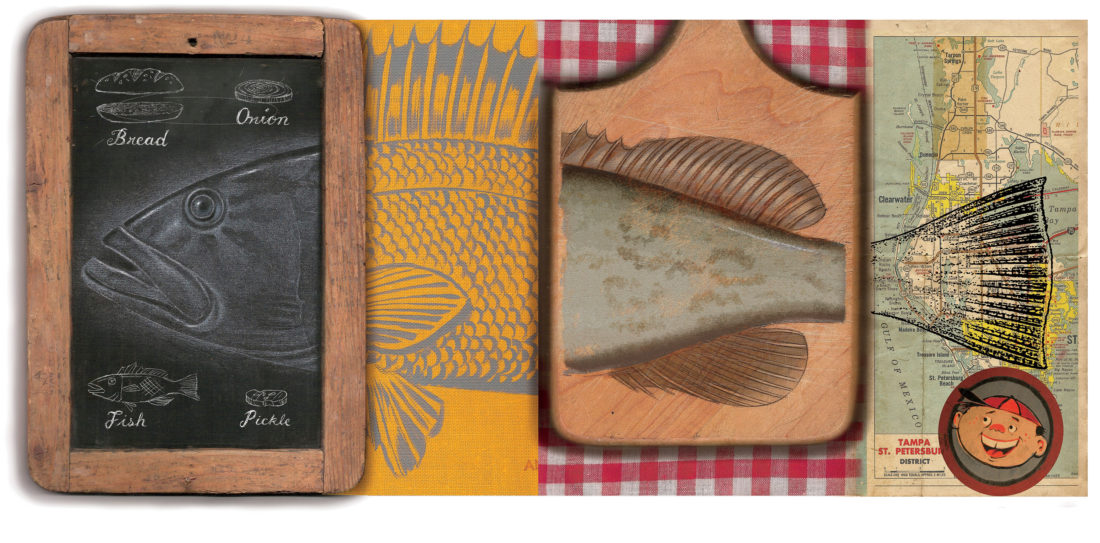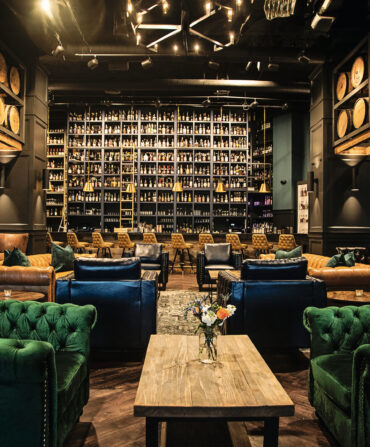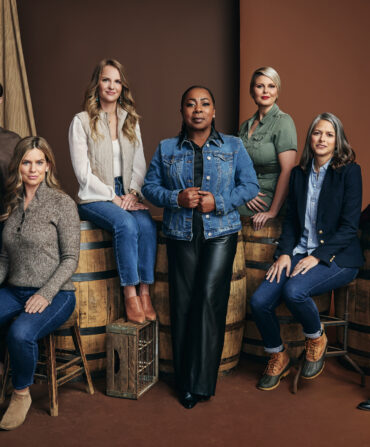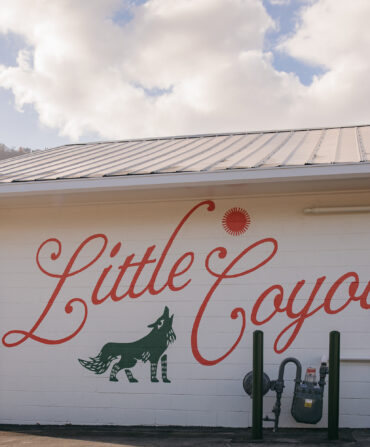Food & Drink
Requiem for a Fish Sandwich
For many Southerners, nothing goes quite as well with summer as a fresh grouper sandwich. But these days finding the real thing can be hit or miss

Photo: Anthony Freda
I love fishing stories, which some people equate with lies. I do not believe this is always true. I think weird things happen when you step boldly off firmer earth, and commence to float. This is my new favorite.
Jimbo Meador, outdoorsman, writer, and other things, was fishing the Yucatán about forty years ago. Not far away, a tiny man, a Mayan he believes, was fishing with a hand line from a tiny boat. Suddenly, the tiny man and his tiny boat went shooting across the water. The tiny boat did not have a motor.
He had hooked a Goliath grouper, and it was taking him for a ride.
“Like The Old Man and the Sea,” said Meador’s friend Skip Jones, who grew up, like Meador, not far from Mobile Bay.
The tiny man hung on, and on, and on.
Finally, he had his prize, and got the weary fish, hundreds of pounds of it, back to the dock.
The tiny man ran a rope through the grouper’s massive maw and gills. “Tied it to a post,” Meador said, like a horse.
There was no electricity there, no ice. So they tied the live fish to the dock to swim, to keep, till they decided it was time to eat.
Meador told it at lunchtime over fried chicken, since there was no grouper to be had. As the story hung in the air, as all good stories will, I was not thinking of hot weather in exotic places, or fish fights, or Hemingway.
I pictured a five-gallon bucket of tartar sauce, and a hundred hamburger buns.
Just how many sandwiches, I wondered, would that big ol’ boy have made?
But it seems all the great grouper stories are old stories, now. The Goliath grouper, fished relentlessly, is a protected species, other types of big grouper have been sorely depleted, and the grouper sandwich seems, sometimes, more like a dream.
I remember a recent birthday when all I wanted was a grouper sandwich. It was late summer, ninety-five degrees in the descending dusk. I had been waiting for two hours; you should not wait two hours for anything in this life except surgery, and at least then they have the decency to knock you out. As I waited, I sat on a hard bench in the humidity and watched children play in dingy sand and scream, which is to say they mostly just screamed. One little boy was flinging sand—I think it was mostly dirt—high in the air. Children are not wise enough not to look up, or close their mouths, when a dirt cloud falls.
The restaurant had about the same seating capacity as Legion Field, one of those places on the Redneck Riviera where we, as a Southern people, have been conditioned across our lifetimes to sit and sweat into our aloe-vera-anointed sunburn for many, many hours for some fried and blackened seafood, all the while clutching one of those flasher-buzzy things in our slick palms, or anxiously waiting for our names to drift from a loudspeaker like Saint Peter calling us home. A restaurant in Destin, Florida, asks to keep your car keys, lest you run off with its priceless buzzer-flashy. I am not making this up.

Photo: Jason Myers
Fish House
Patrons enjoy lunch.
I recall that, down the bench, a young man with numerous eyebrow piercings and more tattoos than a harpooner from Moby-Dick was enthusiastically trying to suck the lips off a young woman with blue hair. I am pretty sure I sighed. I do not know why we submit to all this for a sandwich, even a grouper sandwich; I guess because we think that, when it comes, it will be hand delivered by a backstroking Weeki Wachee mermaid. But it never is.
In such times, I often slink back into the past, into nostalgia, where the passing years have rubbed and buffed all the rough edges from things. I closed my eyes and thought of grouper sandwiches long ago, as the lovers slurped, and the children screamed.
I will never forget my first. It was more than twenty years ago. I arrived in Clearwater, Florida, dead broke, except for rent money and some change in a pickle jar. I came to write for the Clearwater bureau of what was then the St. Petersburg Times, one of the great newspapers. I have always had a fascination with palm trees. The Gulf Coast seemed exotic, and still does; I don’t care how many snowbirds cross my path in black socks and Bermuda shorts. But by the time I paid for a concrete-block, one-bedroom apartment, I did not have money for furniture, or food. I lived three weeks on banana sandwiches, washing them down with cold water from plastic jugs my mother filled before I left home. Florida water, she knew, was not fit for drinking or even putting out a brush fire. I read a paperback copy of Lonesome Dove, twice, on a bare terrazzo floor, and listened to my stomach gurgle. After my first paycheck, reporters invited me to lunch for a grouper sandwich. The only fish sandwich I had ever had came in a sack with an action figure called a Hamburglar. My expectations were not high, but I was hungry.
To this day, I do not know if it was the sandwich or the scenery. The sand of Clearwater Beach stretched wide and white to water the color of emeralds. Mermaids were everywhere. The place was called, I believe, Julie’s, one of many there known for their fish sandwiches, for grouper, and mahi. The grouper was grilled, dripping with cool, lemony tartar sauce and dressed with a thick slice of genuine, ripe, non-gassed tomato, an antidote for every pink, bad tomato I ever had. God ripened that tomato, just for me.
The first bite was clean and not fishy, but the thing I remember most is the consistency, the flesh firm, thick, and meaty, with none of those gray streaks of nastiness that taste like fish gone bad. I would have them, over time, grilled, fried, and blackened, from almost every kind of grouper in the Gulf, Atlantic, and Caribbean. I remember whole days of my life better because of them. I loved them, me and everyone else, and I guess we loved them about to death.

Photo: Jason Myers
The blackened grouper sandwich.
Most people, younger, have never had them the way they used to be. It was not, in fact, a fillet at all. It was a slab. “Three inches thick,” recalls Pete Blohme, a chef, owner of the landmark Panini Pete’s restaurant in Fairhope, Alabama. “I sure do miss ’em. Brings tears to my eyes, just thinking about ’em.”
It did not look like fish, really, those sandwich fillets. There was no taper to the fillet, just an irregular, fat, square chunk, one of many fat, square chunks carved from something massive.
“I was eight years old, the first time I saw one, and we had just moved to South Florida…Fort Lauderdale,” says Blohme, whose café au lait and beignets are a Saturday morning tradition in Baldwin County. His father had taken him to a seafood warehouse, a place where massive fish lay or hung, waiting to be cleaned and processed. Stone crab claws were piled on ice. But it was the grouper that fascinated him.
“I saw grouper bigger than me,” a hundred pounds, more. “They were huge.”
“Beautiful,” he says.
Then, he had his first taste.
“It tasted like the ocean. A little salt, a little brine. It was like that smell,” that smell when you stand by the open water. “You take a bite, and go, ‘Aaahhhh…’ You knew where it came from.”
Like the redfish, which became so symbolic in Louisiana cooking it was almost eaten into extinction, the grouper became shorthand for the beach, a vacation delicacy.
“It was common,” Blohme says. “By the late 1970s, grouper was king.”
They hung like great cows in the murky water, and would bite almost any bait, live or dead. In the 1980s, deep-sea fishing boats, on the Gulf and Atlantic sides, unloaded them like slabs of beef. By the late 1980s and into the 1990s, marine biologists warned that without careful management many kinds of grouper would virtually disappear. I know it makes me a hypocrite, since I did my part to eat them into oblivion.
“I guess they fished all them big ol’ fat fish out,” Blohme says.
Sometimes, I suspect the grouper inside the bun may be fooling me.
The fillets are scrawny, and look like, well, catfish.
“Sometimes, it’s that counterfeit grouper,” Blohme says.
I was still a young man when I arrived in Miami the first time, almost a quarter century ago, to write about one of the most compelling places on earth. I have never liked mornings, but there was something about the morning light in Miami, something golden. I would get in my ’69 Firebird convertible and rumble out to Key Biscayne, to a cool, dark bar at the Silver Sands motel. I would order a grouper sandwich for my 11:30 breakfast, and watch the European mermaids play in the calm, flat water. I remember the grouper inside the bun was good, fresh, real, and delicious, every time. It was Florida. I thought, in that cool dark, I had the best life a man could live, right then, right there. I know, I have buffed this memory. I know, nostalgia is a veil, a piece of colored glass. I know. But I had a fried grouper sandwich and onion rings for breakfast. Other people were staring at shredded wheat, and hoping to live forever. But I bet forever is a long time with shredded wheat.
There are many kinds of grouper, most at one time either threatened or protected, in varying degrees of commercial appeal and distress. There are black, gag, red, yellowfin, yellowedge, red hind, rock hind, or speckled hind, and, of course, Goliath, easy to identify because they have been described as being the size of a Mini Cooper, and are prone to lurk under fish boats and eat hooked fish like Tic-Tacs. One tried to eat Cameron Diaz once, but that is another story.
State and federal protections ebb and flow, ease and tighten, but people who grew up by the water say the grand days of grouper are over. Competing restaurants squabble—some even use DNA testing as proof—over who is serving real grouper. On the Alabama coast, it can be hard to find a grouper sandwich like the slabs of old, or one of any kind, though I did find one a few miles inland that tasted of cat food. Gulf Coast restaurants largely feature mahi, or use sutchi, triggerfish, or other fish as an alternative to grouper. In the Gulf, overfishing is not the grouper’s sole peril, since the Deepwater Horizon spill. Marine biologists have warned it may be years before the lingering impact of the disaster comes to light. For now, people here continue to celebrate the recovery, a return to normalcy. Sometimes, the past is not better. This part of our past may haunt us for a long, long time.

Photo: Jason Myers
Grouper on the wall of Dockside Dave's in Madeira Beach, Florida.
One of the last holdouts from the old plenty of the grouper seems to be the Tampa Bay area, where the grouper sandwich is said to have been invented, where places like Frenchy’s Rockaway Grill, in Clearwater, and Dockside Dave’s, in Madeira Beach, and the Sandbar, in Anna Maria, still consider the sandwich a signature dish. Down in Miami, the grouper sandwich at Garcia’s is frozen only in time, a fresh slab of the way things used to be. Such places are often the first stop I make, to taste the past.
I almost drowned once swimming off Bean Point on Anna Maria Island, within sight of the Sandbar. There was a hurricane in the Gulf and the waves were massive. I had always liked that phrase “storm-tossed,” and I felt big and brave, thrown into the air, till the undertow got me. I staggered into knee-deep water, finally, exhausted. That afternoon I had a fine grouper sandwich, to celebrate being alive, and at dusk joined a group of elderly ladies doing water aerobics in the shallow surf, which I often did then as protection from sharks. This was as much of a man of the sea, I decided, as I needed to be.
I was in my final hour of hell at the big seafood restaurant, my final hour of toddlers apparently raised by wolves. My number was up and I shuffled like a man on a chain gang to a table made to look like one at a tiki bar. The sandwich, when it came, was not grouper, but then the menu had not claimed it was. I had not known, as I languished, that there was no grouper sandwich here, but it was too late. I do not know its origin, that fish, though it was fine enough. But I decided, then, to travel across the Gulf to Anna Maria someday soon, to see if they still make as good a sandwich there as they used to, there at the Sandbar or places near, and maybe see if any of the old mermaids from that water aerobics class still know my name.







